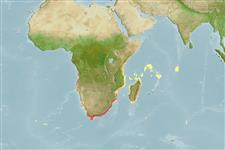Environment: milieu / climate zone / depth range / distribution range
Ecología
marino; salobre; oceanodromo (Ref. 51243). Tropical
Southeast Atlantic: known only from Mossel Bay and the Kosi Estuary in South Africa. Reported from Angola (Ref. 3468) and Mozambique (Ref. 12484).
Length at first maturity / Tamaño / Peso / Age
Maturity: Lm 38.0 range ? - ? cm
Max length : 75.0 cm TL macho / no sexado; (Ref. 4393); peso máximo publicado: 3.1 kg (Ref. 4699)
Espinas dorsales (total): 5; Radios blandos dorsales (total): 8; Espinas anales 3; Radios blandos anales: 9
Occur mainly in estuaries, congregating over mud-banks (Ref. 2830). Oviparous, eggs are pelagic and non-adhesive (Ref. 205). Omnivore (Ref. 97629). Fleshy highly esteemed (Ref. 4393).
Life cycle and mating behavior
Madurez | Reproducción | Puesta | Huevos | Fecundidad | Larva
van der Elst, R., 1981. A guide to the common sea fishes of southern Africa. C. Struik, Cape Town. 367 p. (Ref. 3670)
IUCN Red List Status (Ref. 130435)
Threat to humans
Harmless
Human uses
Pesquerías: escaso valor comercial; pesca deportiva: si
Más información
ColaboradoresImágenesStamps, Coins Misc.SonidosCiguateraVelocidadTipo de nataciónSuperficie branquialOtolitosCerebrosVisión
Herramientas
Special reports
Download XML
Fuentes de Internet
Estimates based on models
Preferred temperature (Ref.
123201): 18.5 - 26.3, mean 24.9 °C (based on 34 cells).
Phylogenetic diversity index (Ref.
82804): PD
50 = 0.5005 [Uniqueness, from 0.5 = low to 2.0 = high].
Bayesian length-weight: a=0.01445 (0.00822 - 0.02541), b=2.96 (2.81 - 3.11), in cm total length, based on LWR estimates for this species & Genus-body shape (Ref.
93245).
Nivel trófico (Ref.
69278): 2.5 ±0.16 se; based on food items.
Resiliencia (Ref.
120179): Bajo, población duplicada en un tiempo mínimo de 4.5-14 años (Preliminary K or Fecundity.).
Fishing Vulnerability (Ref.
59153): Moderate to high vulnerability (50 of 100).
